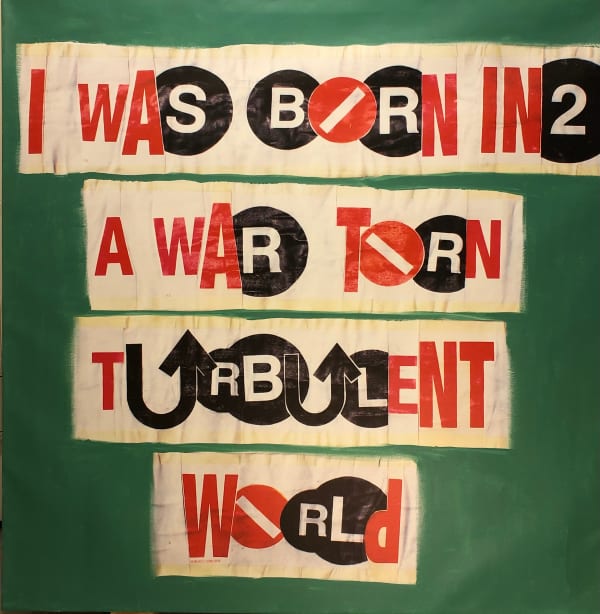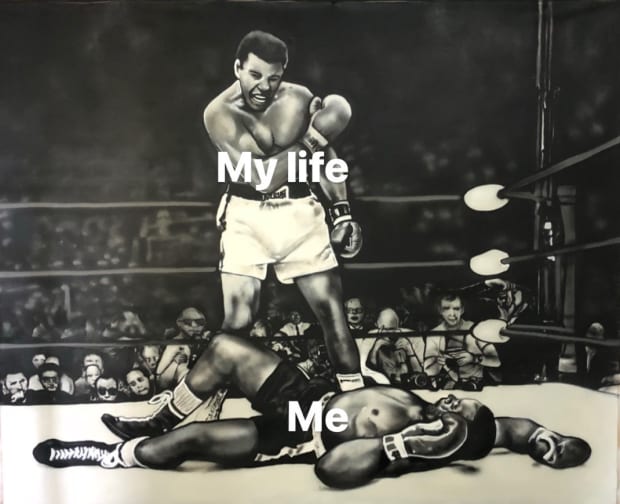PULPO GALLERY is pleased to present THE PROOF IS ONLY OCULAR as it takes a closer look at artists with a penchant for painting, drawing, and transcribing words, texts, and acronyms, and how such verbalization makes us see differently. We at PULPO GALLERY view art as the true lingua franca of the world that has the power to unite. It transcends boundaries, dictates, and rules. It blurs reasoning and clarity to allow for surprise, delight and magic. It turns the obvious on its head and makes truth seem like a dare.
The artist in this show gives voice to the more universal components of communicating in myriad creative ways. And that primordial communication, absent our iphones and social media, is the truest, most timely, and invaluable art form. And the form with the greatest of limitless possibilities. Communication opens doors. And transforms lives. For the better. Funnily enough, expression is a synonym for word. Something to remember when reading art—the expressive and exalted communique from artists. In so many words. —Gregory de la Haba
Come with us and explore works by Richie Culver, Al Diaz, Gardar Eide Einarsson, Mishka Henner, Jim Joe, Martin Kippenberger, Nate Lowman, Lushsux, Oscar Murillo, Laure Prouvost, Scott Reeder, Marcos Siega, Jim Torok, Taylor White and Adrian Wilson.
-
Richie Culver
Hypersensitive 6 Star All-Nighter (2018)
-
-
Richie Culver
Richie Culver has much to say and even more to show for it. His paintings of sparse imagery and text are culled snippets of life’s opposing forces at play: high-brow versus low; good versus evil; clean versus drug-addled; funny versus not-so-funny. “I wanted to paint within the grey areas of English culture,"says the self-taught artist from Hull, a working-class hood in northern England. And he does. In CHASE MONEY, Mr. Culver doesn’t give the viewer much to look at in terms of pictorial imagery and wonderment. There is no big yellow star, no dashing greyhound, no pigeon looking to fly the coop. The painting of acrylics and lacquer on canvas consist merely of black words scrawled atop a whitewashed background with flickers of color here and there. The font is simple and crude like its dictate to go and chase money. It does, however, within its simplicity and as preface to the work’s main, capitalistic theme, proffer a longing in memory by way of utilizing the once famous lyrics, DONT [sic] GO CHASING WATERFALLS. This, the first stanza of CHASE MONEY is taken from the catchy, chart-topping song, Waterfall, from the mid 90’s by the American hip-hop group, TLC. Mr. Culver doesn’t immediately strike one as a fan of TLC but then again he was 15 years of age and learning the craft of mischief when Waterfall was a worldwide sensation. Winning MTV’s Video of The Year Award in 1995 to boot. But it does makes perfect sense that Mr. Culver would choose such a beautifully sung and composed song that voices, beneath its pop-tune-culture-surface, the horrors of the AIDS epidemic (the first number one song to do so), drugs and promiscuity. For this is indeed the grey area life unfolds to all of us regardless of upbringing. It is contradictory and painful, yet full of potential and promise. And it’s always been artists like Mr. Culver who—with their own unique light—point that out to us most simply. Gently. Like a fortune in a Fortune Cookie revealing one’s lucky numbers on one side along with some ancient Chinese wisdom on the other, Mr. Culver attunes us to the flip side of everything. An alternative. And in doing so creates gems in poetic dissonance and absolute goodness. A lasting positive from 2020’s unforgiving death grip. - Gregory de la Haba
-
-
Oscar Murillo
With his ‘inventive and itinerant’ modus operandi already on full display while still a graduate student in London at the Royal Academy of Art, the Colombian-born, multidisciplinary artist, Oscar Murillo (b. 1986), brings cultural exchange and dialogue—drawn from his Spanish-speaking roots for his English-speaking audience—front and center with his 2011 painting, Untitled (Drawing Off The Wall). Firstly, to do anything ‘off the wall’ is to do it in a bizarro-type fashion. Inscribing the spanish word for chicken, pollo, on the bottom half of a six-foot-square painting is a perfect example of such behavior. But Murillo’s work may allude to something deeper, the nuance most certainly lost in verbatim translation: there was a time not too long ago that fresh chicken was a luxury food in Colombia’s big cities. Like Wagyu beef is today. Back in the day, to have asked the rhetorical question, ¿Y eso quién pidió pollo? (Who ordered the chicken?) was to have implied how expensive something was. But words and phrasing, like people, get intermingled, are always in flux. Today, chicken is readily available and super inexpensive in Colombia, yet the idiom with the question persists. Only, its meaning has been altered and is now employed as a device to acknowledge exceptional beauty - eye-candy, male or female. And for Murillo, perhaps to art as well. Painting as delicious booty. Sabroso como pollo. And for the masses to savor. - Gregory de la Haba
-

-
Al Diaz
Street-artist-pioneer and wordsmith extraordinaire, Al Díaz co-created the most storied tag of all time, SAMO©, with his childhood friend and partner-in-crime, Jean-Michel Basquiat. Al Díaz is a first-generation New York City graffiti artist who continues to create, exhibit and share his experiences as a key figure in the counterculture art scene from the city's graffiti heyday. His Signage studio paintings are verbalisms of unadulterated poetry from a life of observance on the street; hand-crafted by way of utilizing posters and public announcement notices lifted from the city’s subways and station houses. The creation of which are dictated by availability in both the content of said posters/notices and the materiality of which they are made or designed. The MTA's "Service Change Alert" posters along with the likes of "Wet Paint" signs become the templates from which to work and arrange his own lexicon. Surprisingly, amongst the MTA's arsenal of signage, the letters H, O, U, Y, X, K, and V are no where to be found. "That's where the art comes in," says Al. "The challenge to create something new with limited means." By his own rules, he can never write 'shit', it must be 'fecal' —for there is no 'h' in the underground. "It becomes a mental game." One that unravels as satirical as Banksy, these works are poignant messages that question our world order by way of street-savvy chutzpah and farce. Genius in simplicity. Brilliant in richness and depth. - Gregory de la Haba
-
Al Diaz
SAMO -
Laure Prouvost
Turner Prize winner Laure Prouvost who also represented her native France in the 2019 Venice Biennale delves into the flaws and idiosyncrasies of language as starting point to create art that walks a fine line between what is and what is not, between fiction and reality, imagined or real. Through language, whether expressed or implied, written or painted, filmed or sung, Ms. Prouvost’s imagination runs wild and often in absurd and hilarious ways. Her work might best be enjoyed (and understood) with the words of her fellow countryman, François-Marie Arouet, in mind. Known better by his nom de plume, Voltaire, the internationally acclaimed 18th century writer, historian, and philosopher—who also loved language and was a staunch advocate for free speech—once quipped: “God is a comedian playing to an audience too afraid to laugh.” Because if we approach Ms. Prouvost’s The Person Behind Wants To Talk To You without the slightest bit of laughter or merriment billowing from within, we might wish to have our faculties checked. Especially if we turned around to see if anyone was actually standing behind us, yes, after reading it? - Gregory de la Haba
-

-

-
Taylor White
Summer Puppies - 2018 Acrylic, charcoal, pastel, and stitching on canvas
70 x 80 in
178 x 203 cm -
Taylor White
Summer Puppies - 2018The American artist Talyor Anton White (b.1978) follows in a long and honorable line of artists whose start began in the military. John McCracken, Harvey Keitel, Oliver Stone, Shaggy, and the painter of happy trees, Bob Ross, were veterans before the world realized their creative talents as distinguished as their valor. For Mr. White, the nine years spent as Marine before attending college in his 30’s was the ready-made-primer to commence his late-to-the-game art practice. One that at first glimpse is precisely as is appears: a haphazard assemblage of materiality (found or crafted), of layered, disparate patterns utilizing bold colors, tactile texturing and strewn together as if forming a wildly abstract yet familiar puzzle harkening back to our childhood, and to times of playfulness when all was still innocent. And fun. Often, the pieces of canvas or carpeting are sewn together. The seam, therefore, acts as a counterpoint to Mr. White’s heavy-use of line painted thick or thin, drawn or airbrushed and always in a frenetic, child-like scribble but utilized just the same: as a visual tool to guide in the eyes traversing within the picture’s framework much the way they’d tango within Caravaggio’s chiaroscuro. And we happily abide in White’s commanding order. Spring Puppies anyone? - Gregory de la Haba
-

-
Nate Lowman
A MoMA Affiliate Alkyd on canvas
60 x 72 x 2 in
152.4 x 182.9 x 5.1 cm -
More Works
-



















